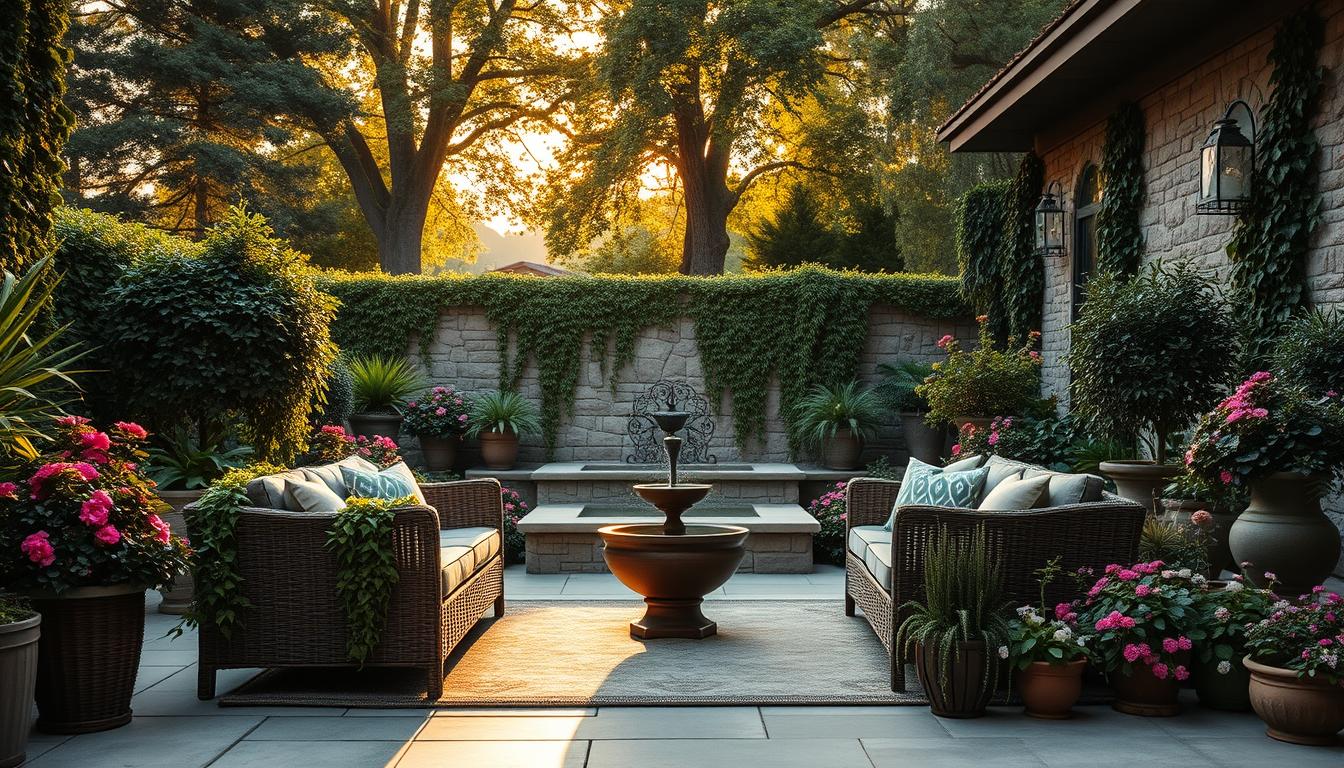Imagine stepping through your back door into a personal sanctuary. It feels like an extension of your home. This is the magic of outdoor living spaces. Even a small backyard can become a stunning retreat for relaxation and entertainment.
Creating your dream outdoor area is easy. You don’t need a landscape architecture degree or a big budget. The key is to understand how you want to use your space. Then, make smart choices about layout, materials, and greenery.
In this guide, we’ll cover the essential elements of patio garden design. You’ll learn about plants that thrive in your climate and furniture that encourages conversation. You’ll get practical tips for spaces of any size.
Whether you’re starting from scratch or refreshing an existing area, this guide is for you. It will help you create an outdoor sanctuary that reflects your style. Let’s start the journey to transform your outdoor space into the retreat you’ve always wanted!
The Magic of Outdoor Living: Why Patio Gardens Matter
Outdoor living is more than just decoration. It’s about making spaces that care for our bodies and souls. A good patio garden turns a simple backyard into a special place for life’s big moments. These areas are key parts of our homes, offering benefits that indoor spaces can’t.
Health Benefits of Garden Spaces
Being in your backyard is great for your health. Studies from the University of Minnesota show it can lower stress and blood pressure quickly.
Even small patio gardens bring big health perks:
- Improved air quality from plants that clean pollutants
- More vitamin D from sunlight
- Less anxiety and depression
- Better sleep from evening outdoor time
- More exercise from gardening
Extending Your Home’s Living Area
A well-designed patio adds useful space to your home without the usual costs. It’s a flexible area that changes with the seasons.
Today’s outdoor spaces do many things. They’re perfect for morning coffee or big parties. Many people love their patios for meals, talks, and quiet time.
Creating a backyard oasis is more than following trends. It’s making a useful part of your home that improves your life and offers a personal escape.
Assessing Your Patio Space: The First Step to Success
To turn your patio into a garden paradise, start by knowing your outdoor space well. Just like an artist plans their canvas, you must understand your patio before designing. This step is crucial for making choices that save time, money, and avoid frustration.
Evaluating Sun Exposure and Microclimates
The sunlight your patio gets is key for choosing plants and where to place furniture. Spend a day watching how sunlight changes across your space. Note where it’s full sun, partial shade, and full shade.
Remember, the sun’s position changes with the seasons. A sunny spot in summer might be shady in fall. Your patio also has microclimates, like areas near walls or fences, that can be warmer or cooler than others.
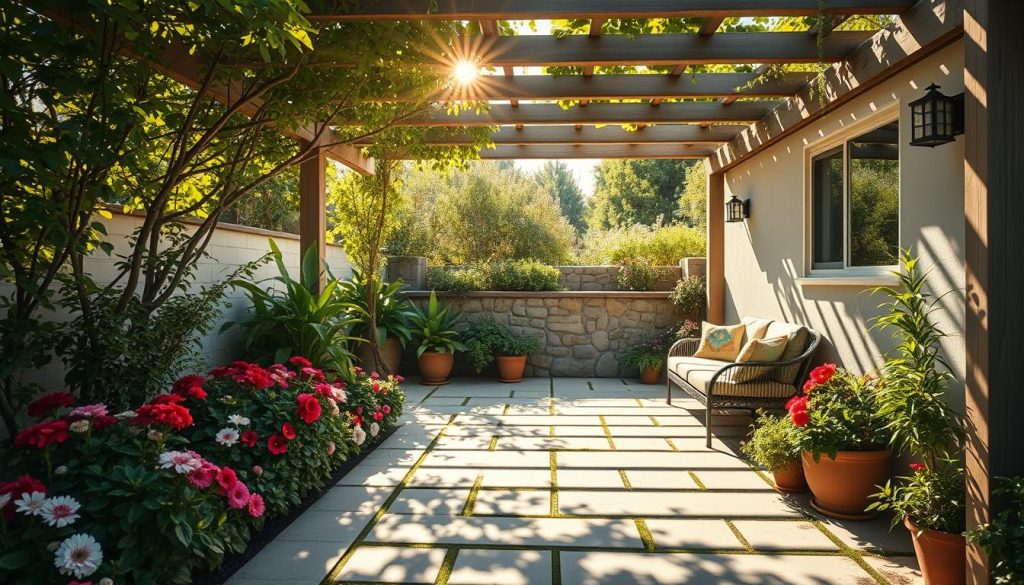
Understanding Your Space Limitations and Opportunities
Every challenge in your patio can lead to a creative solution. Awkward corners can be cozy reading spots, and narrow spots can be vertical gardens.
Measure your space carefully and mark off permanent features like doors and windows. Think about your patio’s shape, any changes in elevation, and what materials it’s made of. These aren’t just obstacles but can inspire your design.
Identifying Traffic Patterns and Functional Needs
How people move through your patio affects its use. Watch where people naturally go and gather. This helps you see where you need different areas.
Consider how you want to use your patio. Do you need a dining area, a place to relax, or a play area for kids? Drawing a simple diagram of these areas helps you see how your design can meet your needs while keeping the space easy to move through.
Principles of Effective Patio Garden Design
Every beautiful patio garden starts with careful design. It doesn’t matter if you have a big backyard or a small balcony. Knowing the basics helps you create a space that looks good and feels right. Let’s dive into the key principles that make a patio special.
Balance, Proportion, and Scale
Balance is key to a stable patio design. Symmetrical designs use the same elements on both sides, giving a formal look. Asymmetrical designs are more relaxed but need careful placement of elements.
Proportion and scale are about how elements fit together. Getting this right makes your patio feel right, not awkward.
- Avoid oversized furniture that overwhelms small patios
- Skip tiny planters that get lost in expansive spaces
- Match the height of plants to your wall or fence dimensions
- Consider the mature size of plants when planning your layout
Creating Visual Flow and Movement
Good patio design leads the eye through the space. Use pathways to guide visitors. Curved lines are relaxing, while straight paths are more formal.
Repeating colors, shapes, or materials creates rhythm. Focal points, like a striking container, give the eye a place to rest.
Plants can suggest movement. Grasses sway, vines climb, and flowers cascade, adding energy to your space.
Incorporating Privacy Elements
Privacy turns an open patio into a cozy spot. Use layered plants for natural screening. Tall grasses, dense shrubs, or columnar trees block views.
Structures like lattice panels or pergolas with plants add privacy and interest. Even big containers with tall plants can change with your needs.
Privacy elements should fit with your design. Plan them early for a look that’s both practical and beautiful.
Defining Your Patio Garden Style
The style of your patio garden can turn an ordinary space into a special backyard oasis. Style is more than looks; it shapes your plant choices, material picks, and design. A garden with a unified style feels like a natural part of your home.
Contemporary vs. Traditional Approaches
Contemporary patio gardens love clean lines and simple plants. They use modern materials and geometric shapes. This style is perfect for those who like simplicity and bold looks.
Traditional gardens, on the other hand, follow classic designs. They use natural stone, brick, and wood. These gardens have lush plants and ornamental details, making them feel timeless.
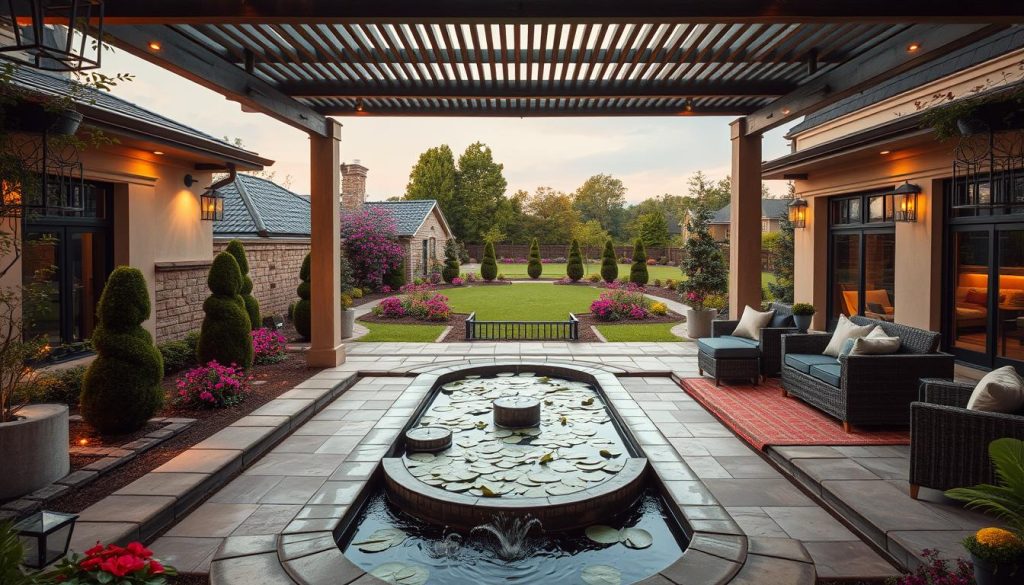
Popular Garden Themes for American Patios
American garden themes vary, influenced by climate and personal taste. Mediterranean gardens use drought-resistant plants and warm colors, perfect for sunny areas. They’re easy to care for.
Cottage gardens are charming and informal, with lots of flowers and whimsical touches. Japanese gardens focus on peace, with rocks, water, and carefully pruned plants.
Desert/xeriscape gardens are great for dry areas, featuring succulents and gravel paths. Tropical gardens bring a lush, exotic feel with bright flowers and water features.
Matching Garden Style to Your Home’s Architecture
Your home’s style can guide your garden design. Colonial homes look good with formal, symmetrical gardens. Craftsman homes pair well with gardens that use natural materials and native plants.
Mid-century modern homes need gardens with clean lines and bold shapes. Ranch homes are best with relaxed, horizontal layouts that connect indoors and outdoors.
While guidelines help, your personal taste should lead. The best garden is one that makes you happy every time you step outside.
Creating Your Backyard Oasis: Layout Strategies
A well-designed backyard oasis starts with smart layout strategies. These strategies divide your patio into zones for different activities. Think of your outdoor space as a blank canvas where each area has its own purpose.
Strategic planning turns ordinary patios into extraordinary outdoor living spaces. These spaces meet your unique lifestyle needs.
Zoning for Different Activities
Effective zoning makes your outdoor retreat multi-functional. It supports your daily routines and special occasions. Think about which activities are most important to your household when planning your layout.
Common activity zones include:
- Relaxation areas with comfortable seating and shade options
- Dining spaces near kitchen access
- Cooking zones with grills, prep surfaces, and storage
- Play areas for children or pets
- Gardening sections with easy water access and sun exposure
The key is to create distinct zones while keeping the space visually cohesive. Use planters, outdoor rugs, or slight level changes to define zones without physical barriers.
Designing Conversation Areas
The heart of any backyard oasis is a well-designed conversation area. Position seating to encourage interaction. Keep seating 4-8 feet apart for easy conversation.
Create a focal point like a fire pit or water feature. Arrange seating in a U or circular shape around it. This promotes eye contact and conversation flow.
Incorporating Dining and Entertainment Spaces
Outdoor dining areas make meals memorable. Position your dining space for shade during meals and to fit your typical gathering size plus extra guests.
For entertainment zones, consider these elements:
- Weather-resistant surfaces for food and drink preparation
- Strategically placed lighting for evening enjoyment
- Versatile seating for different events
- Audio capabilities that don’t disturb neighbors
Thoughtful transitions between zones create a cohesive outdoor living space. Use consistent materials, colors, and elements to tie your backyard oasis together. This allows each area to serve its unique purpose.
Selecting the Perfect Plants for Your Patio Garden
Plants are the heart of your patio garden. Choosing the right ones can make it thrive or become a hassle. The best plants are both beautiful and easy to care for. This way, your garden stays lively all year and fits your schedule.
Climate-Appropriate Plant Selection
Knowing your local climate is key to a great patio garden. The USDA Hardiness Zone Map helps you pick plants that will do well in your area. For example, Zone 4 in Minneapolis is very different from Zone 10 in Miami.
Native plants are great for patios. They grow well in your area and need less care than other plants. They also attract local wildlife, making your garden more interesting.
Think about your patio’s microclimate when picking plants. South-facing patios get a lot of sun, while north-facing ones are shadier. Walls can block wind but also trap heat. These small details affect how plants grow.
Creating Year-Round Visual Interest
A good patio garden looks good all year. Instead of just focusing on summer flowers, choose plants that look good in every season. Spring bulbs, summer perennials, and autumn leaves all add to the beauty.
Don’t forget about winter. Evergreen shrubs and ornamental grasses keep your garden looking good when it’s cold. Plants with interesting bark or berries add color in the winter.
Layer plants of different heights and bloom times. This way, something is always interesting to look at. Mixing plants with different foliage adds interest even when there are no flowers.
Low-Maintenance Options for Busy Gardeners
If you don’t have a lot of time for gardening, choose low-maintenance plants. Succulents like sedum and echeveria need very little water. They come in many colors and shapes, adding style to your patio.
Native ornamental grasses are easy to care for and look great. They move in the wind and add interest in winter. They rarely need to be divided or pruned.
Woody shrubs like boxwood and hydrangea are also low-maintenance. They need only occasional pruning and look good all year. Many new varieties are compact and perfect for containers.
Edible Options for Patio Gardens
Adding edible plants to your patio garden is a smart idea. Herbs like rosemary and thyme are not only tasty but also attract pollinators. They come in compact forms that are great for containers.
Dwarf fruit trees and berry bushes are perfect for small spaces. They offer fruit and flowers, and some even change color in the fall. Even in a small space, you can grow your own food.
Vertical gardens are a great way to grow more food in less space. Trellised cucumbers and strawberries are easy to grow and add greenery to your patio. They keep your food away from pests.
| Plant Type | Maintenance Level | Climate Adaptability | Seasonal Interest | Special Features |
|---|---|---|---|---|
| Sedum varieties | Very Low | Zones 3-9 | Summer-Fall | Drought-tolerant, pollinator-friendly |
| Dwarf Hydrangeas | Low-Medium | Zones 5-9 | Summer-Fall | Long-lasting blooms, compact size |
| Ornamental Grasses | Very Low | Zones 4-10 | All Seasons | Movement, winter structure, texture |
| Dwarf Fruit Trees | Medium | Varies by type | Spring-Fall | Flowers, fruit, sometimes fall color |
| Herbs (Rosemary, Thyme) | Low | Zones 5-10 | Spring-Summer | Fragrance, edible, pollinator-friendly |
Container Gardening: Versatile Solutions for Any Patio
Container gardening is amazing because it fits any patio, big or small. It’s perfect for balconies or big backyards. You can make beautiful gardens without the hassle of digging.
Planters make your garden easy to change. You can move them to get more sun or to look better. This is great for renters or people who move a lot.
Choosing the Right Containers for Your Space
Picking the right containers is key for a great patio garden. The material, size, and style affect your plants and how your garden looks. Think about weight, durability, and how they fit with your patio.
| Container Material | Pros | Cons | Best For |
|---|---|---|---|
| Terracotta | Breathable, classic look, natural cooling | Heavy, breakable, dries out quickly | Mediterranean styles, herbs, drought-tolerant plants |
| Ceramic | Decorative, retains moisture, wide variety | Expensive, heavy, can crack in freezing temps | Focal points, tropical plants, formal settings |
| Plastic/Resin | Lightweight, affordable, durable | Can fade, less breathable, may tip in wind | Large plants, beginners, budget-friendly designs |
| Metal | Modern look, durable, weather-resistant | Conducts heat/cold, can rust, expensive | Contemporary designs, heat-loving plants, accents |
Make sure your container has holes for drainage. If it doesn’t, drill holes or use it as an outer pot with a draining inner pot.
Plant Combinations That Thrive in Containers
Creating a great container garden is more than just putting plants in pots. Use the “thriller, filler, spiller” method. This means a tall plant (thriller), medium plants (fillers), and plants that spill over (spillers).
For sunny spots, try purple fountain grass as the thriller, lantana as the filler, and sweet potato vine as the spiller. For shade, use caladium as the thriller, impatiens as the filler, and creeping Jenny as the spiller.
Think about the seasons when planning your containers. Spring might have tulips and daffodils. Summer has warm-weather annuals. Fall has ornamental kale and mums. Winter has evergreen boughs and berried branches.
Maintenance Tips for Container Gardens
Container gardens need special care. They dry out fast, so water often. Check the soil by sticking your finger in it; water when it’s dry.
Feed your plants often because the soil loses nutrients. Use slow-release fertilizers and liquid fertilizer every 2-4 weeks in growing season.
Change the soil every year because it gets old. Prune and deadhead to keep plants looking good. In winter, protect plants from cold by moving them or wrapping them up.
With the right planning and care, container gardening can make your patio beautiful and flexible. It can change with your needs and tastes.
Innovative Landscaping Ideas for Patio Spaces
The art of patio landscaping has changed a lot. Homeowners now have many ways to make their outdoor spaces special. Modern designs add structure, sensory features, and artistic touches to make your patio feel like part of your home.
These designs turn simple patios into personal retreats. They show off your style and increase your home’s value.
Incorporating Hardscape Elements
Hardscaping is key to a great patio garden. It includes permanent structures that add shape and interest.
Decorative paving can make your patio look better. Try using natural stone, brick pavers, or stamped concrete. These materials can be arranged in patterns that match your home.
Retaining walls and raised beds do more than just look good. They help with yard slopes and offer places to plant. This makes your patio feel bigger, even if it’s small.
- Pergolas and arbors frame views and create shade while supporting climbing plants
- Decorative screens offer privacy and add beauty
- Stone pathways guide you through the space and connect different areas
- Built-in seating walls save space in small patios
Choose hardscape materials that match your home. Natural stone fits well with traditional homes, while concrete and metal work for modern ones. The goal is to blend indoor and outdoor spaces smoothly.
Water and Fire Features
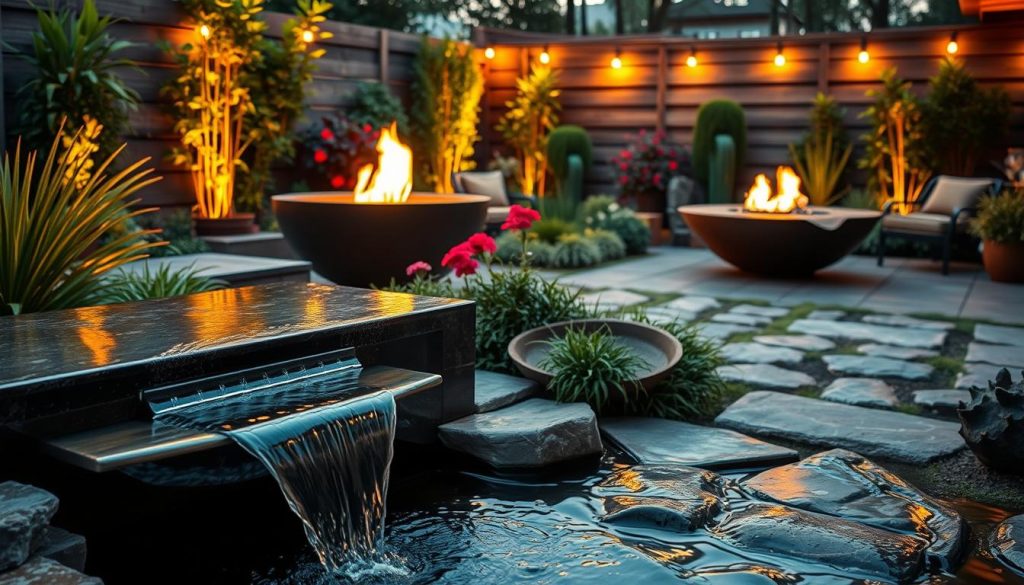
Water and fire features add a lot to your patio. They make your garden a place that engages your senses.
Water features calm your patio with sounds and coolness. You can have small fountains or big waterfalls. The sound of water helps block out city noise and brings peace.
Fire features make your patio great for evenings. You can have fire bowls, pits, or fireplaces. They provide warmth, light, and a place for people to gather.
Try mixing water and fire for a stunning look. A fire bowl with a water channel or a fireplace with a waterfall is amazing. It makes your patio feel like a resort.
Creating Focal Points and Visual Interest
A good patio garden has focal points that catch your eye. These points give your space character and make it interesting.
Standout plants are great focal points. Think about a Japanese maple, an olive tree, or an agave. They add beauty and can be lit up at night.
Artistic elements let you show your style. Use sculptures, pottery, or outdoor art. These pieces can change with the seasons or stay all year.
Lighting changes your patio at night. Use it to highlight textures, patterns, or special features. Solar lights are easy to use without electrical work.
When planning focal points, be careful not to overdo it. Too many things can make your patio look messy. Use one main focal point and a few others to guide your eye.
Furniture and Accessories: Completing Your Outdoor Room
It’s not just plants and hardscaping that make your patio special. The right furniture and accessories turn it into a cozy outdoor living space. They make your patio a place where you can relax, dine, and socialize.
Choosing the right garden furniture is key. It should be durable and comfortable. Accessories add a personal touch and make your space unique.
Weather-Resistant Furniture Options
When picking furniture, think about how it will hold up outside. Different materials work better in different climates and with different care needs.
Teak furniture is a top choice for its beauty and durability. It gets a silver look over time and lasts long with little care. Cedar and acacia are good, affordable wood options if you seal them properly.
Powder-coated aluminum is durable and light. It’s easy to care for and comes in many styles. Modern synthetic wicker looks like real wicker but lasts longer in the sun and rain.
Think about what you need when picking furniture. Stackable or foldable pieces are great for small spaces. Modular furniture is flexible. Always test how comfortable it is before buying.
Accessorizing Your Patio Garden
Accessories can make your patio feel like your own. Weather-resistant cushions and pillows add color and comfort. Choose fabrics that dry quickly and are made for outdoor use.
Outdoor rugs define areas and add warmth. They’re easy to clean and come in many styles. Layered lighting, like string lights and lanterns, creates a cozy atmosphere in the evening.
Shade is important for comfort on hot days. Umbrellas, pergolas, and awnings keep you cool. Decorative items like art and mirrors add style and interest.
Storage Solutions for Garden Tools and Supplies
Good storage keeps your patio looking neat and protects your things. Multi-functional furniture is a smart choice. Look for benches and ottomans that hide cushions or tools.
Dedicated storage units, like deck boxes and sheds, are practical. Choose materials that match your garden’s style. Wall-mounted options save space and keep tools within reach.
Use weatherproof bags or containers for off-season items. This keeps them safe and extends their life. Proper storage saves money and keeps your patio ready for use.
Small Space Gardening: Maximizing Tiny Patios
Even the smallest outdoor spaces can become amazing garden havens with the right approach. Small space gardening challenges you to think creatively about using every square inch. When working with limited patio areas, thoughtful planning is key. The results can be stunning, sometimes even more impressive than larger gardens.
Vertical Gardening Techniques
When horizontal space is limited, look upward! Vertical gardening multiplies your growing area by using walls, fences, and other vertical surfaces. Wall-mounted patio planters create living tapestries of color and texture while preserving precious floor space.
Trellises offer excellent support for climbing plants like jasmine, clematis, and morning glories. Living walls, sometimes called green walls, provide dramatic visual impact and can significantly improve air quality in urban settings. Hanging baskets suspended from pergolas or eaves add dimension and bring plants to eye level.
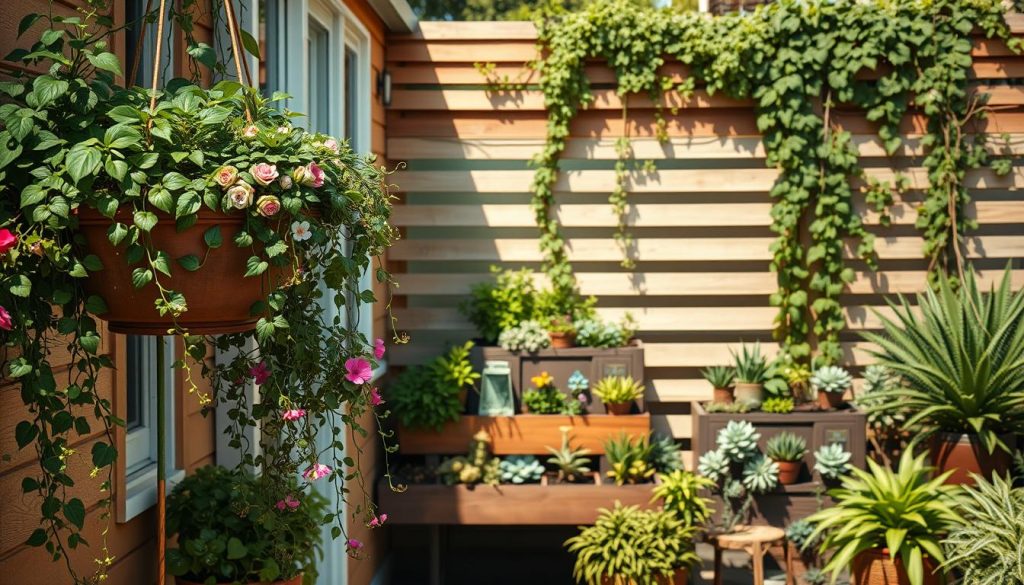
Some plants naturally excel in vertical settings. Consider these vertical-friendly options:
| Plant Type | Examples | Benefits | Care Level |
|---|---|---|---|
| Climbing Vines | Ivy, Jasmine, Clematis | Creates living walls, provides privacy | Low to Medium |
| Trailing Plants | Pothos, String of Pearls | Cascades beautifully from hanging planters | Low |
| Compact Herbs | Thyme, Rosemary, Mint | Practical for cooking, pleasant aromas | Medium |
| Succulents | Sedum, Echeveria | Drought-tolerant, minimal soil needed | Very Low |
Multi-Functional Design Elements
In small patio gardens, every element should serve multiple purposes. Storage benches with cushioned tops can house garden tools while providing seating. Tables with built-in central planters create conversation pieces that double as herb gardens right where you dine.
Modular furniture offers flexibility to reconfigure your space for different occasions. Consider stackable planters that create visual interest while maximizing growing space. Folding or nesting furniture can be tucked away when not in use, creating more room for entertaining or relaxation.
Patio planters with casters allow for easy rearrangement as the sun patterns change throughout the day. This mobility ensures your plants receive optimal light while giving you the freedom to refresh your layout whenever desired.
Creating the Illusion of Space
Strategic design choices can make tiny patios feel surprisingly spacious. Mirrors placed thoughtfully reflect light and greenery, visually doubling your garden’s size. Consider mounting a weather-resistant mirror on a wall or fence to create this effect.
Color plays a crucial role in spatial perception. Light-colored pavers, furniture, and pots create an airy feeling, while dark colors tend to make spaces feel smaller. Cool colors like blues and greens recede visually, making boundaries seem farther away.
Lighting transforms small patios after dark. String lights overhead draw the eye upward, creating a sense of height. Solar path lights guide movement through the space, while uplighting plants creates dramatic shadows that add depth and mystery.
Remember that negative space—areas intentionally left empty—prevents small gardens from feeling cluttered. A carefully edited collection of fewer, larger patio planters often creates more impact than numerous small containers. This restraint allows each plant to shine while maintaining a sense of openness in your small space garden.
DIY Garden Projects to Enhance Your Patio
It’s easy to add a personal touch to your patio garden with DIY projects. Making your own garden elements saves money and connects you to your outdoor space. The joy of saying “I made that” about a beautiful planter is unmatched.
Weekend Projects for Immediate Impact
Transform your patio in just a couple of days with quick projects. You can make custom patio planters from cedar fence pickets in an afternoon. A bubbling water feature from stacked pots adds soothing sounds.
Building a raised bed along your patio edge creates a garden border. It also gives space for herbs and flowers. You’ll need basic tools like a drill, hammer, and saw.
Upcycling Ideas for Garden Elements
Give old items new life in your garden. Wooden pallets can become vertical planters or garden walls. Even a forgotten ladder can become a tiered plant display.
Old dresser drawers can be turned into charming planters. Chipped teacups and vintage colanders are perfect for succulents and vines.
Budget-Friendly Solutions
Make your patio look great without spending a lot. Mix your own potting soil for less money. Build trellises from bamboo and twine instead of metal ones.
Use wine bottles as garden edging or make stepping stones from concrete. Simple solar lights are also affordable.
| DIY Project | Time Required | Skill Level | Materials Cost | Tools Needed |
|---|---|---|---|---|
| Cedar Planter Box | 3-4 hours | Beginner | $25-40 | Drill, saw, measuring tape |
| Pallet Vertical Garden | Weekend | Intermediate | $10-15 | Hammer, sandpaper, staple gun |
| Pot Water Fountain | 2 hours | Beginner | $50-75 | Drill with bit |
| Concrete Stepping Stones | 1 hour plus drying time | Beginner | $15-20 | Bucket, trowel |
| Wine Bottle Edging | 2-3 hours | Beginner | Free (recycled) | Shovel, level |
From Dream to Reality: Bringing Your Patio Garden Design to Life
Ready to transform your outdoor space? Start by creating a realistic budget. This should cover plants, materials, and any professional help you might need. Breaking your patio garden design into phases makes larger projects more manageable and budget-friendly.
Consider which elements deserve priority in your plan. Hardscaping typically comes first, followed by larger plants and trees, with decorative touches added last. This logical sequence ensures your core landscaping ideas take root before adding finishing details.
Decide whether to tackle the project yourself or hire professionals. Simple container arrangements and basic planting are perfect DIY projects. For complex hardscaping or electrical work, professional contractors bring expertise that saves time and prevents costly mistakes.
Be prepared for common challenges like weather delays and unexpected soil issues. Building extra time into your schedule helps manage these inevitable bumps without stress.
Plan for maintenance from the beginning. Even low-maintenance patio garden designs require some care. Creating a simple calendar for seasonal tasks keeps your outdoor space looking its best year-round.
Remember that gardens are living spaces that evolve over time. The patio you create today will mature and change, offering new joys with each season. By applying the principles and landscaping ideas from this guide, you’ll create an outdoor retreat that enhances your home and lifestyle for years to come.

